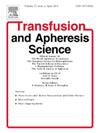Fresh and cryopreserved stem cell transplantation in myeloma patients: Does it make a difference on transplant outcomes?
IF 1.2
4区 医学
Q4 HEMATOLOGY
引用次数: 0
Abstract
Objective
The standard approach for multiple myeloma patients eligible for transplantation includes 4–6 cycles of induction therapy, followed by autologous stem cell transplantation (aHSCT). The aHSCT process starts with stem cell mobilization and collection, followed by high-dose chemotherapy and reinfusion of the harvested stem cells. These cells can be infused fresh within 24–48 h post-collection or cryopreserved for future use. Herein we analyzed the outcomes of aHSCT patients receiving infusions of fresh versus cryopreserved hematopoietic stem cells.
Materials and methods
This multicenter retrospective study analyzed 88 adult patients diagnosed with multiple myeloma who underwent aHSCT (n = 43 for cryopreserved; n = 45 for fresh infused group).
Results
A total of 88 patients were included in the study. 39.7 % of patients were female and 60.3 % of patients were male. No correlation was observed between pre-mobilization disease status, mobilization regimen, and disease risk status as defined by the R-ISS system (p = 0.1, p = 0.8). The median neutrophil engraftment time was 10 days in the fresh group and 12 days in the cryopreserved group (p < 0.01). In contrast, the median platelet engraftment time was 12 days in the fresh group and 11 days in the cryopreserved group (p < 0.01). Engraftment was achieved in all patients included in the study.
Conclusion
The shorter neutrophil engraftment time in the fresh group and the shorter platelet engraftment time in the cryopreserved group, along with successful engraftment in all patients, suggest that both options are reasonable within the MM aHSCT protocol.
新鲜和低温保存的骨髓瘤干细胞移植:对移植结果有影响吗?
目的符合移植条件的多发性骨髓瘤患者的标准方法包括4-6个周期的诱导治疗,然后进行自体干细胞移植(aHSCT)。aHSCT过程从干细胞动员和收集开始,然后是大剂量化疗和收获的干细胞再输注。这些细胞可以在收集后24-48 h内新鲜输注或冷冻保存以备将来使用。在此,我们分析了aHSCT患者接受新鲜造血干细胞输注与冷冻保存造血干细胞输注的结果。材料和方法本多中心回顾性研究分析了88例诊断为多发性骨髓瘤的成年患者,他们接受了aHSCT (n = 43,冷冻保存;N = 45(新鲜注射组)。结果共纳入88例患者。39.7 %为女性,60.3 %为男性。运动前疾病状态、运动方案与R-ISS系统定义的疾病风险状态之间无相关性(p = 0.1,p = 0.8)。新鲜组中性粒细胞移植时间中位数为10 d,低温保存组为12 d (p <; 0.01)。相比之下,新鲜组的中位血小板植入时间为12天,低温保存组为11天(p <; 0.01)。所有纳入研究的患者均成功植入。结论新鲜组中性粒细胞植入时间较短,低温保存组血小板植入时间较短,且所有患者均成功植入,提示在MM aHSCT方案中,这两种选择都是合理的。
本文章由计算机程序翻译,如有差异,请以英文原文为准。
求助全文
约1分钟内获得全文
求助全文
来源期刊
CiteScore
3.60
自引率
5.30%
发文量
181
审稿时长
42 days
期刊介绍:
Transfusion and Apheresis Science brings comprehensive and up-to-date information to physicians and health care professionals involved in the rapidly changing fields of transfusion medicine, hemostasis and apheresis. The journal presents original articles relating to scientific and clinical studies in the areas of immunohematology, transfusion practice, bleeding and thrombotic disorders and both therapeutic and donor apheresis including hematopoietic stem cells. Topics covered include the collection and processing of blood, compatibility testing and guidelines for the use of blood products, as well as screening for and transmission of blood-borne diseases. All areas of apheresis - therapeutic and collection - are also addressed. We would like to specifically encourage allied health professionals in this area to submit manuscripts that relate to improved patient and donor care, technical aspects and educational issues.
Transfusion and Apheresis Science features a "Theme" section which includes, in each issue, a group of papers designed to review a specific topic of current importance in transfusion and hemostasis for the discussion of topical issues specific to apheresis and focuses on the operators'' viewpoint. Another section is "What''s Happening" which provides informal reporting of activities in the field. In addition, brief case reports and Letters to the Editor, as well as reviews of meetings and events of general interest, and a listing of recent patents make the journal a complete source of information for practitioners of transfusion, hemostasis and apheresis science. Immediate dissemination of important information is ensured by the commitment of Transfusion and Apheresis Science to rapid publication of both symposia and submitted papers.

 求助内容:
求助内容: 应助结果提醒方式:
应助结果提醒方式:


